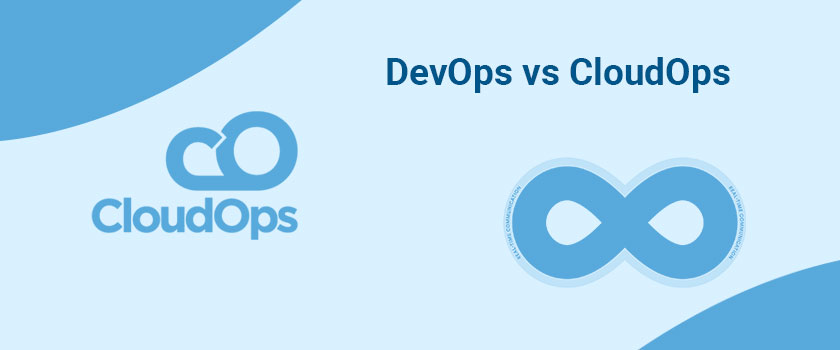
What is CloudOps?
Organizations are migrating their infrastructure to the cloud
with the intent of enhancing scalability while optimizing
performance and capacity. Irrespective of which platform is
used or infrastructure location, CloudOps provides
organizations with proper resource management. In an
organization, CloudOps uses DevOps principles and IT
operations applied to a cloud-based architecture to speed up
the business processes. CloudOps relies on continuous
operations, and this approach is adopted from
DevOps.
What is DevOps?
In DevOps development and operations teams are taken together
to accelerate the business processes linked with the software
teams and the services they provide on any cloud platform. The
main objective of DevOps teams is to provide organizations
with improved communication between development and IT teams.
The core of DevOps stresses to reduce the amount of time
required to deploy any software or updates.
Difference between DevOps and CloudOps
When it comes to DevOps, automation is the key. It delivers
agile and repeatable processes to get the best final product.
Contrary, CloudOps is a way of doing DevOps, but without using
any on-site network server assets. It takes advantage of
powerful cloud computing tools like Amazon Web Services(AWS),
Google Cloud Platform(GCP), and Azure.
Key Differences Between the Two:
-
Affordability:
With the enormous number of cloud-based platforms
available, CloudOps providers compete for quality and
prices. The organizations that use cloud computing do not
have to worry about maintaining an expensive network
architecture on-site. In fact, they can team up with the
cloud service providers to get support for all
networking/server needs without compromising on
affordability.
However, DevOps is relatively a new concept and its
experts are in huge demand because of the rising
popularity of DevOps, hiring an expert can be costly.
Plus, making changes to your existing software
infrastructure is also an expensive option.
-
Expansion Ready:
With CloudOps, organizations can get better expandable
storage and processing power as per their needs. But in the
case of DevOps, when your dependence on the on-site
infrastructure is massive, expanding or upgrading complete
infrastructure to optimize software delivery is not as easy.
Besides being an expensive option, it’s a
complicated procedure too.
-
Primary Focus:
DevOps engineers handle both projects, whether it’s a
cloud-based application or downloadable software. Contrary,
Cloud engineers work to design cloud systems for the
organization itself. In this way, DevOps seems a viable
option, as it provides more freedom to the
organization.
Benefits of Cloud-Based Platforms for DevOps:
-
Efficiency:
Cloud-based platforms are incredibly efficient to use as
they are not tied to a physical location; they can be
accessed from anywhere. As developing on the cloud allows
users to showcase their applications quickly, it allows
faster time-to-market.
-
Scalability:
Cloud-based platforms are best for businesses with
fluctuating bandwidth demands. This scalability can provide
organizations with an added advantage over their
competitors. It also reduces the risks linked to maintenance
and operations.
-
Disaster Recovery:
IT organizations face the risk of losing all their data and
not able to recover it. But when organizations opt for
cloud-based platforms, they don't have to worry about it
anymore; the cloud assures that the data is always
available, even if laptops or PCs are damaged. For all sorts
of emergency scenarios, cloud services are always available
with a quick data recovery solution.
Challenges While Adopting CloudOps:
Moving to new technology can be challenging, whether it is
DevOps or CloudOps. If you’re planning to move to
CloudOps then you may encounter any of the following
challenges:
-
Additional Layers of Scrutiny:
CloudOps works using dashboards and tools that automate the
monitoring process, but that doesn't eliminate the need for
hardware; cloud-based platforms also require a physical
server to operate. This might involve an extra layer of
troubleshooting and maintenance from both the cloud help
desk and the traditional help desk.
-
A Comprehensive Strategy Is a Must:
To ensure a smooth transition, the right expertise and
guidance are required, and because many of these
technologies are new, it's challenging to get the needed
support from the limited pool of people. Thus, to have a
successful and robust CloudOps transformation, a consistent
plan is required.
-
Compliance Issues:
Organizations often face compliance issues while migrating
to CloudOps. It is the duty of IT governance to ensure that
IT assets are implemented and used according to the terms
and policies and that they are being maintained and
controlled.
CloudOps Best Practices:
Obviously, integrating CloudOps into your process can be
difficult but you can’t deny the fact that it has a lot
to offer. So instead of scrapping it out, consider
implementing the following best practices:
-
Provisioning: CloudOps provides organizations with a different kind of
provisioning like managing the provisions of machine
insights on the cloud. There are two types of provisioning
available. The first is self-provisioning, which allows the
cloud users to have their own machines, and organizations
can track the usage. The other one is auto-provisioning, as
the name suggests, in this, applications themselves request
more machines, and they can automatically de-provision the
machines when no longer required.
-
Setting Limits: CloudOps best practices involve setting limits as to what
all can be done within the public cloud environment. With a
cloud-based environment, a user can provide their own
machine, but it's almost impossible to set up 1,000 machines
at a time. This is the reason why setting limits is required
to ensure that applications are being managed within budgets
only.
-
Automation:
It's essential to automate almost everything. This can
include anything from user management to API governance.
When automating the CloudOps processes, organizations can
themselves understand that most of the processes follow a
naturally repeatable pattern, which further helps in
automating the processes.
-
Self-Healing:
While automating the processes, it would be a great thing to
introduce the self-healing capabilities of the cloud
provider. This means automated procedures should have the
capability to correct minor issues by themselves.
Conclusion
CloudOps is the advanced version of DevOps. As more
organizations are shifting towards Cloud platforms, it makes
sense to use CloudOps, but there are plenty of limitations
that will make you think twice before you move to such
platforms.
In this article, we have listed down the potential
complexities that you might come across, so if you are
planning to incorporate CloudOps as your preference, please
make sure they read them. Also, keep the best practices in
your mind while setting up your new CloudOps initiative.


